The Mesozoic Era is the era of Earth's geological history, lasting from about 252 to 66 million years ago, comprising the Triassic, Jurassic and Cretaceous Periods. It is characterized by the dominance of gymnosperms like, cycads, ginkgoaceae and araucarian conifers and of archosaurian reptiles, such as the dinosaurs; a hot greenhouse climate; and the tectonic break-up of Pangaea. The Mesozoic is the middle of the three eras since complex life evolved: the Paleozoic, the Mesozoic, and the Cenozoic.

The Triassic is a geologic period and system which spans 50.5 million years from the end of the Permian Period 251.902 million years ago (Mya), to the beginning of the Jurassic Period 201.4 Mya. The Triassic is the first and shortest period of the Mesozoic Era and the seventh period of the Phanerozoic Eon. Both the start and end of the period are marked by major extinction events. The Triassic Period is subdivided into three epochs: Early Triassic, Middle Triassic and Late Triassic.

Bivalvia or bivalves, in previous centuries referred to as the Lamellibranchiata and Pelecypoda, is a class of aquatic molluscs that have laterally compressed soft bodies enclosed by a calcified exoskeleton consisting of a hinged pair of half-shells known as valves. As a group, bivalves have no head and lack some typical molluscan organs such as the radula and the odontophore. Their gills have evolved into ctenidia, specialised organs for feeding and breathing.

Gryphaea, one of the genera known as devil's toenails, is a genus of extinct oysters, marine bivalve mollusks in the family Gryphaeidae.

The Nautilida constitute a large and diverse order of generally coiled nautiloid cephalopods that began in the mid Paleozoic and continues to the present with a single family, the Nautilidae which includes two genera, Nautilus and Allonautilus, with six species. All told, between 22 and 34 families and 165 to 184 genera have been recognised, making this the largest order of the subclass Nautiloidea.

Clam shrimp are a group of bivalved branchiopod crustaceans that resemble the unrelated bivalved molluscs. They are extant and also known from the fossil record, from at least the Devonian period and perhaps before. They were originally classified in the former order Conchostraca, which later proved to be paraphyletic, because water fleas are nested within clam shrimps. Clam shrimp are now divided into three orders, Cyclestherida, Laevicaudata, and Spinicaudata, in addition to the fossil family Leaiidae.

Placodonts are an extinct order of marine reptiles that lived during the Triassic period, becoming extinct at the end of the period. They were part of Sauropterygia, the group that includes plesiosaurs. Placodonts were generally between 1 and 2 m in length, with some of the largest measuring 3 m (9.8 ft) long.

The Late Triassic is the third and final epoch of the Triassic Period in the geologic time scale, spanning the time between 237 Ma and 201.4 Ma. It is preceded by the Middle Triassic Epoch and followed by the Early Jurassic Epoch. The corresponding series of rock beds is known as the Upper Triassic. The Late Triassic is divided into the Carnian, Norian and Rhaetian ages.

The Pteriida are an order of large and medium-sized marine bivalve mollusks. It includes five families, among them the Pteriidae.
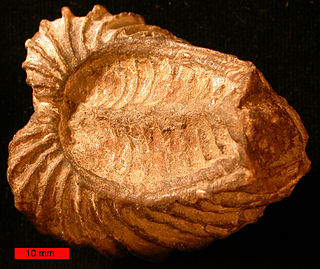
Trigoniidae is a taxonomic family of saltwater clams, marine bivalve mollusks in the superfamily Trigonioidea. There is only one living genus, Neotrigonia, but in the geological past this family was well represented, widespread and common. The shells of species in this family are morphologically unusual, with very elaborate hinge teeth, and the exterior of the shell is highly ornamented.

The Gryphaeidae, common name the foam oysters or honeycomb oysters, are a family of marine bivalve mollusks. This family of bivalves is very well represented in the fossil record, however the number of living species is very few.
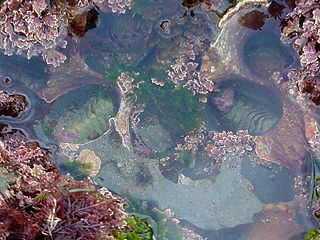
The Mesozoic marine revolution (MMR) refers to the increase in shell-crushing (durophagous) and boring predation in benthic organisms throughout the Mesozoic era, along with bulldozing and sediment remodelling in marine habitats. The term was first coined by Geerat J. Vermeij, who based his work on that of Steven M. Stanley. While the MMR was initially restricted to the Cretaceous, more recent studies have suggested that the beginning of this ecological/evolutionary arms race extends as far back as the Triassic, with the MMR now being considered to have started in the Anisian or the Aalenian. It is an important transition between the Palaeozoic evolutionary fauna and the Modern evolutionary fauna that occurred throughout the Mesozoic.
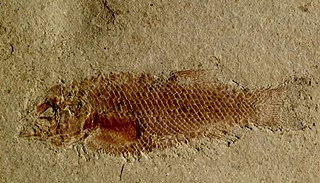
Acentrophorus is an extinct genus of prehistoric freshwater and marine ray-finned fish from the Roadian to the Wuchiapingian of England, Germany (Kupferschiefer), Italy and Russia. There may also be a Triassic occurrence in Australia.

Prolecanitida is an order of extinct ammonoid cephalopods, the major Late Paleozoic group of ammonoids alongside the order Goniatitida. Prolecanitids had narrow shells, discoidal (disc-shaped) to thinly lenticular (lens-shaped). They retained a retrochoanitic siphuncle, a simple form with septal necks extending backwards. As is typical for ammonoids, the siphuncle sits along the ventral margin of the shell.
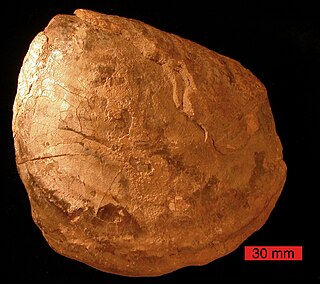
The Inoceramidae are an extinct family of bivalves ("clams") in the Class Mollusca. Fossils of inoceramids are found in marine sediments of Permian to latest Cretaceous in age. Inoceramids tended to live in upper bathyal and neritic environments. Many species of inoceramid are found all over the world, demonstrating the wide distribution of their preferred ecosystems, and possibly long-lived planktotrophic larvae. Despite their wide distribution, the pace of evolution of inoceramids was great, with species ranges commonly averaging 0.2-0.5 Ma.
Pojetaia is an extinct genus of early bivalves, one of two genera in the extinct family Fordillidae. The genus is known solely from Early to Middle Cambrian fossils found in North America, Greenland, Europe, North Africa, Asia, and Australia. The genus currently contains two accepted species, Pojetaia runnegari, the type species, and Pojetaia sarhroensis, though up to seven species have been proposed. The genera Buluniella, Jellia, and Oryzoconcha are all considered synonyms of Pojetaia.

Bakevelliidae is an extinct family of prehistoric bivalves that lived from the Late Mississippian until the Middle Eocene. Bakevelliidae species are found worldwide, excluding Antarctica. Living a stationary life attached to substrate in marine and brackish environments, they formed shells of an aragonite composition with a low amount of magnesium calcite. The family was named by William King in 1850. At least one genus in the family, Hoernesia, has a notably twisted commissure join.

Fordilloidea is an extinct superfamily of early bivalves containing two described families, Fordillidae and Camyidae and the only superfamily in the order Fordillida. The superfamily is known from fossils of early to middle Cambrian age found in North America, Greenland, Europe, the Middle East, Asia, and Australia. Fordillidae currently contains two genera, Fordilla and Pojetaia each with up to three described species while Camyidae only contains a single genus Camya with one described species, Camya asy. Due to the size and age of the fossil specimens, Fordillidae species are included as part of the Turkish Small shelly fauna.
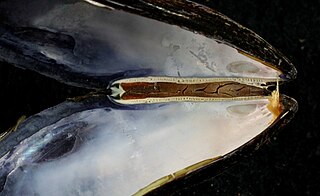
A hinge ligament is a crucial part of the anatomical structure of a bivalve shell, i.e. the shell of a bivalve mollusk. The shell of a bivalve has two valves and these are joined by the ligament at the dorsal edge of the shell. The ligament is made of a strong, flexible and elastic, fibrous, proteinaceous material which is usually pale brown, dark brown or black in color.

Ginglymodi is a clade of ray-finned fish containing modern-day gars (Lepisosteidae) and their extinct relatives in the order Lepisosteiformes, the extinct orders Semionotiformes and Kyphosichthyiformes, and various other extinct taxa. Ginglymodi is one of the two major subgroups of the infraclass Holostei, the other one being Halecomorphi, which contains the bowfin and eyespot bowfin and their fossil relatives.

















